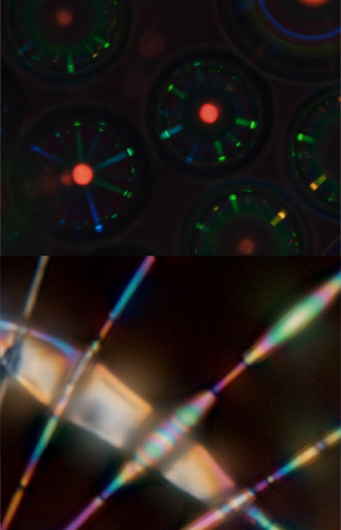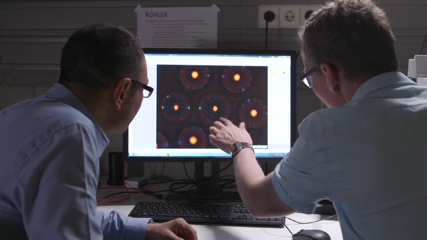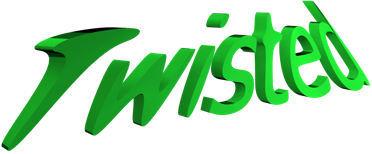Work in Progress - New website layout transfer is in bug fixing mode
Apologies for some errors while thew new site is getting updated.
Look out for new fixes in the new year.
See you in 2018!
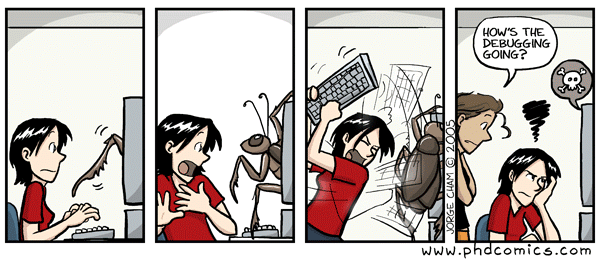
/CGR/
New paper in Advanced Optical Materials
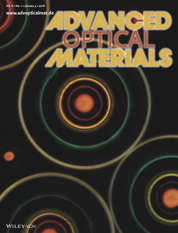
**Update (12.01.17 - POM images fromYong's paper are selected for the inside cover of Advanced Optical Materials! Click the cover above to freely access the article online)
Congratulations to Yong on the publication in Adv. Opt. Mater. titled: “Through the Spherical Looking-Glass: Asymmetry Enables Multicolored Internal Reflection in Cholesteric Liquid Crystal Shells”!
Spheres of cholesteric liquid crystal generate dynamic patterns due to selective reflection from a helical structure subject to continuously curved boundaries. In this paper the patterns are investigated exclusively.
Click here for an extended layman's abstract summary written by Jan & some info about the curious Alice in Wonderland-like title ![]()
/CGR/
We're hosting the next German Liquid Crystal Conference in March 2018!

This will be a two-day conference on the physics, chemistry, applications & any other aspects of liquid crystals, held at the University of Luxembourg from March 21-23, 2018.
This is exciting for our group because it's going to be the 3rd time we host an international conference & it will be the largest one we've done yet. We are currently in close collaborations with groups in Belgium, the Netherlands, & France (note: this is not in competition with the the current French LC & soft matter society meetings).
Please check out the website for registration below!
http://glcc18lux.lcsoftmatter.com/
Also, our Facebook Page for frequent updates for this year's meeting @ https://www.facebook.com/GLCC2018/
(FYI - Early bird deadline for registration and payment is 16th of February 2018!)
Hope to see you for fun talks on LCs in good ole Lux. this coming March!
/CGR/
Welcome to Anupam Sengupta! - Anupam will join the UniLu faculty in physics & materials sci.
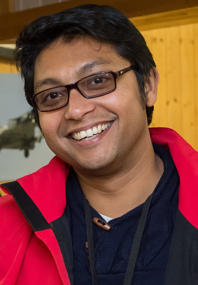
Anupam received the ATTRACT Starting Investigator Grant 2016-17 for his project MBRACE - Microbial Biophysics of Rapid Adaptation in Changing Environments - with Jan Lagerwall as the local promotor.
Anupam Sengupta will join the University of Luxembourg starting in the summer 2018 as an Assistant Professor in the Physics and Materials Science Research Unit. Using a cross-disciplinary approach, MBRACE will interface physics, biology, mathematics and engineering to study biological systems under changing environments, with a particular focus on order and topology inherent in living matter. Anupam holds a Dual Degree in Mechanical Engineering from the Indian Institute of Technology Bombay, India. He received a PhD in Physics for the thesis on Liquid Crystal Microfluidics, which he carried out at the Max Planck Institute for Dynamics and Self Organization, Göttingen, Germany 2009-2012. After a short postdoc in Göttingen, Anupam moved to MIT as a Human Frontiers Cross-Disciplinary Fellow to work on biophysical processes in marine environments. Since fall 2015, he is based at the Institute of Environmental Engineering, ETH Zurich, Switzerland. Here, in addition to marine ecology, Anupam works on microbial behaviour under low and hyper gravity conditions, and looks at bacterial dynamics in natural and nature-inspired ecosystems.
Link to Anupam Sengupta’s website: https://sengupta.mit.edu
We hope to have future collaborations with him & his group once he arrives to Luxembourg!
/written by Anupam, with edits by CGR & JL/
New paper on organic functionalized nanoparticles in nematic LCs
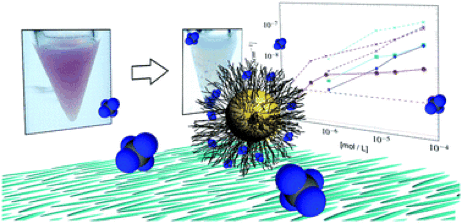
(click the above image to access the article online)
Congratulations to Martin on the publication in J. Mater. Chem. C of his dielectric spectroscopy study “Why organically functionalized nanoparticles increase the electrical conductivity of nematic liquid crystal dispersions”!
This paper gives a first systematic study of how and why nanoparticle doping raises the electrical conductivity of thermotropic liquid crystals like the commonly studied 5CB. By a careful analysis of the dielectric spectra, he shows that the hydrodynamic radius of the ionic charge carrier is much smaller than the nanoparticles, ruling out the particles themselves as the source of conductivity. The ligand molecules are also not the reason, as is demonstrated by strong sonication of the dispersions, such that the ligands detached from the nanoparticles. While this causes nanoparticle aggregation and the loss of suspension stability, the effect on conductivity is negligible. The ligand shell is, however, partially responsible, because the ions giving rise to the conductivity increase are most likely remnants from the ligand-functionalized nanoparticle synthesis process. We propose that these ions are brought in with the ligand shell when the particles are dispersed in the 5CB. Interestingly, the ions appear not to be released in an isotropic and aromatic solvent such as toluene, which is often the host for commercial gold nanoparticle suspensions, but 5CB is an ideal host for their dissolution. The aliphatic ligand shell has a higher compatibility with 5CB than with toluene, thanks to the alkyl tail of 5CB, and at the same time the high polarity of the 5CB (due to the cyano group) allows better ion dissolution than in regular hexane. Finally, the nematic order of the 5CB solvent provides an anisotropic environment in which the ligands are stretched out preferentially along the director, making release of ligand-bound ions to the solvent more likely.
/JL/
New paper on the details of cholesteric LC shell reflection patterns
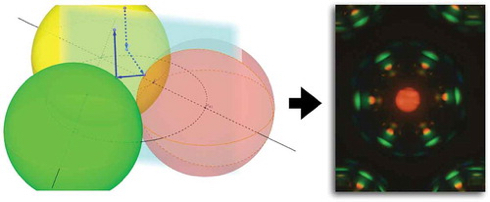
(click the above image to access the article online)
Our fruitful collaboration with Irena Drevensek-Olenik (Ljubljana) and Romano Rupp (Vienna) has resulted in a new article published in Liquid Crystals (special “John Goodby Festschrift” issue). It's also open access!
The paper is entitled “Elucidating the fine details of cholesteric liquid crystal shell reflection patterns” and it combines optical analysis and computer simulations with experimental investigations in the polarizing microscope, allowing a much advanced understanding of the intricate communication patterns arising in collections of short-pitch cholesteric liquid crystal shells, produced using microfluidic techniques. We can now give quantitative information on how the size of the main reflection spot scales with shell size and we explain a number of reflection spots that have previously been ignored. We show that one must consider a certain variation of incidence and reflection angles as well as reflection within the liquid crystal shell in order to explain the patterns. A particularly interesting result is the demonstration and explanation of the first reflection spots that involve communication between three shells: light incident close to the perimeter of one shell can be reflected to an adjacent shell at such an angle that the reflected beam hits a third shell, which then in turn reflects it back to the observer.
/JL/
Statement on diversity
We live in polarizing times when it's become easier than ever to ostracize people just because they may think a bit differently, or look a bit differently, from us, but actually these individual traits can help our communities work and think better.
Have a look at our statement under the Team menu under On Diversity & Inclusion.
/CGR/
New Post-Doc! Manos Anyfantakis joins the team
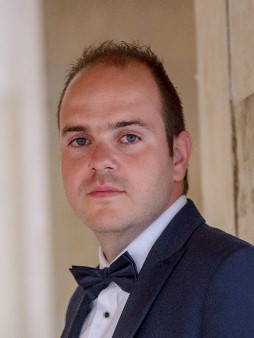
We're happy to welcome our new post-doc: Manos Anyfantakis! He officially joined the ESMP team at the start of July, and will mainly be working on advancing projects related to hydrodynamic flows, kinetic arrest, LC structure formation in the CNC work we have happening. He received his masters applied molecular spectroscopy in 2007, earned a phd in chemistry in Greece in 2010, and has since travelled to Germany and France for postdocs on the wetting of surfactant solutions and optofluidics phenomena before finally joining us in Luxembourg. You can contact Manos via e-mail here.
/CGR/
New Phd Students! Anjali & Shameek
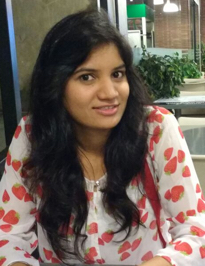
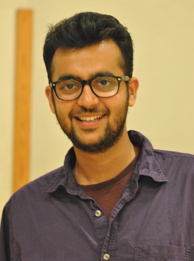
Welcome to both Anjali (left) and Shameek (right) who have joined our team as phd students starting in July.
Anjali will be working on making LC shells for advancing bio-related projects, while Shameek will be working on finding new polymers for advancing applications related to electrospun LC-fibers.
/CGR/
Ross Volpe visits the ESMP group
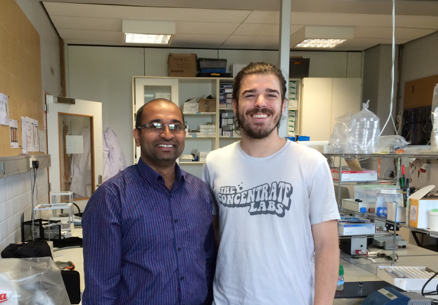
We have the pleasure to be hosting Ross Volpe, Ph.D. candidate, from Prof. Christopher Yakacki's group at the University of Denver, Colorado, USA, until August (the longest we've had a guest over yet!).
During his stay, he will mostly work with Rao on further advancing the actuation of micro shells & also start the development on actuating cylinders. We hope that these months will result in a great collaboration!
/CGR/
We hosted the TWISTED Conference!

On May 10-12, 2017, our ESMP group and the Theory of Soft Condensed Matter Group (headed by Prof. Tanja Schilling) organized and held the Twisted Conference, bringing together many of the leaders, and newcomers, in the CNC and lyotropic liquid crystal fields. There were plenty of useful and interesting discussions on the physics, applications, and chemistry of cholesteric LC phases developing in colloidal suspensions of chiral nanorods. We thank all of the participants for actively engaging in our 2nd (ever!) conference we hosted. Another success
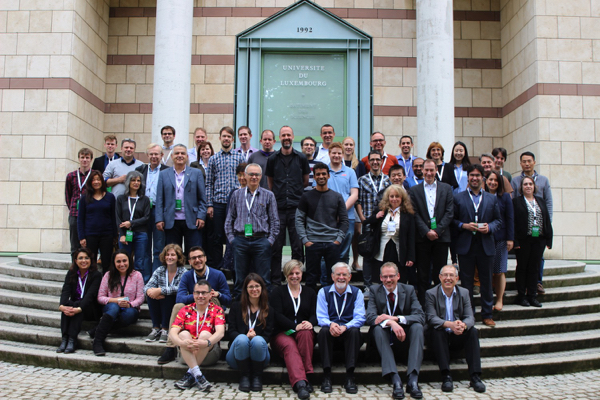
Pictures for participants may be found our sister site: http://www.lcsoftmatter.com/twisted/, using the password provided by Jan.
/CGR/
We have a group logo now (officially)
We finally have something that succinctly shows what our very multidisciplinary group does in the labs, & studies, on a regular basis.
What do you think?
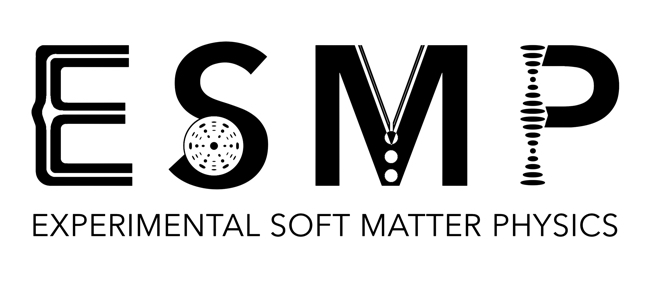
& thanks to our very own Larry H. for the great design!
Variations of the logo will be available for download by group members on the Internal Site soon.
/CGR/
New review article on liquid crystals in droplets, shells, and fibers released
(<— Click to check it out)
With careful and succinct discussions of various topics ranging from the characterization of typical liquid crystalline (LC) phases, to the complexities surrounding LC defects under confinement, we're sure that this review will soon become known as one of the "go-to" manuals for both liquid crystal physicists, and chemists; those just beginning in the field, and veteran researchers alike.
In considering the long length of the article, we've carefully sub-sectioned the important works, advancements, and ongoing research contributing to how liquid crystals behave in each of the major curved configurations (i.e. droplets, shells, and fibers). This was done so that anyone interested in knowing more about a particular topic can easily find the right section without having to start reading from the very beginning. At the same time, we include a number of cross-references serving as reminders for the reader to review certain previously described concepts when necessary.
Finally, at the end of each configuration topic we conclude the sections by highlighting the latest research trends which the LC field has shown interest in — for LCs in droplets and shells, it ends with a discussion of active and motile LC systems (inspired by the flocking mechanism in many biological systems) and liquid crystal elastomer (LCE) actuating shells. For LCs in polymer fiber confinement, the section ends with a discussion on textile based gas responsive visual aids, and comparisons to current gas sensing systems.
Here's a brief outline of every section & contents within:
1. Intro
2. The liquid crystalline states of matter [thermotropic nematics & smectics, order parameter, clarification of terminology for LC orientations, LC deformations & elasticity, cholesterics, LC elastomers (LCEs)]
3. Liquid crystal shells and droplets [microfluidics - what it is, how it works for making LC shells & droplets; issues surrounding interface stabilization & LC alignment control within; topological defects for nematic, cholesteric, smectic droplets and shells; droplet & shell LCE actuatiors; active LC droplets & shells]
4. Core-sheath fibers with encapsulated LC [known behaviors of nematics, smectics, cholesterics in silica cylindrical capillaries; electrospinning basics for inserting LCs into polymer cylindrical (and non-cylindrical) fibers; issues surrounding solvent, polymer concentration and molecular weight choices with particular LCs; various LC molar mass types in polymer fibers; LCE fibers and gas sensing applications]
5. Outlook
/CGR/
Christina Schütz joins the team
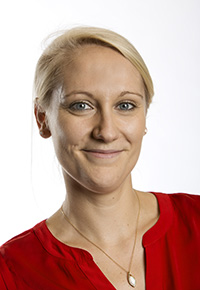
You can contact Christina via e-mail here.
/CGR/
New webmaster for lcsoftmatter.com!
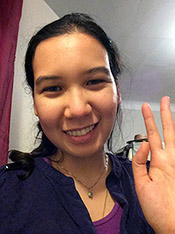
And don't worry, Jan isn't totally going to disappear from this site! (he is our PI after all) He's just getting his own personal site with all of his lectures up and running now too. Once it's ready I'll announce it on here. If you need to contact him though, you can still send him a message through the Contact page, or through his regular University of Luxembourg email address.
Finally, I just wanted to say that I think 2017 is going to be another great year for our group, full of new ideas & exciting research. It's my hope that the site can actually keep up with all the progress we make too.
Toodles*,
Catherine
*Toodles - A shortened anglicized version of the French phrase: à tout à l'heure, which generally means "see you later"







